Select step
- Define the purpose of the valve in the equipment or device, determine the working conditions of the valve: applicable medium, working pressure, working temperature, etc.
- Determine the nominal size and connection mode of the pipe connected to the valve: flange, thread, welding, etc.
- Determine the way to operate the valve: manual, electric, pneumatic or hydraulic, electropneumatic linkage, etc.
- Select the type of valve: closed-circuit valve, regulating valve, safety valve, etc.
- Determine the type of valve: gate valve, globe valve, ball valve, butterfly valve, throttle valve, safety valve, pressure reducing valve, steam trap, etc
- Determine the selected valve shell and inner parts of the material according to the medium, working pressure, working temperature in the pipeline transmission: ductile iron, gray cast iron, malleable cast iron, carbon steel, alloy steel, stainless acid steel, copper alloy, etc..
- Determine valve parameters.
Basis for valve selection
- The use, working condition and operation mode of the selected valve.
- The properties of the working medium: working pressure, temperature, corrosion performance.
- Requirements for valve fluid characteristics: flow resistance, discharge capacity, sealing grade, etc.
- Installation dimension and external dimension requirements: nominal size, connection mode and connection dimension with pipe, external dimension or weight limit, etc.
- Additional requirements for reliability, service life of valve products and explosion-proof performance of electric devices.



